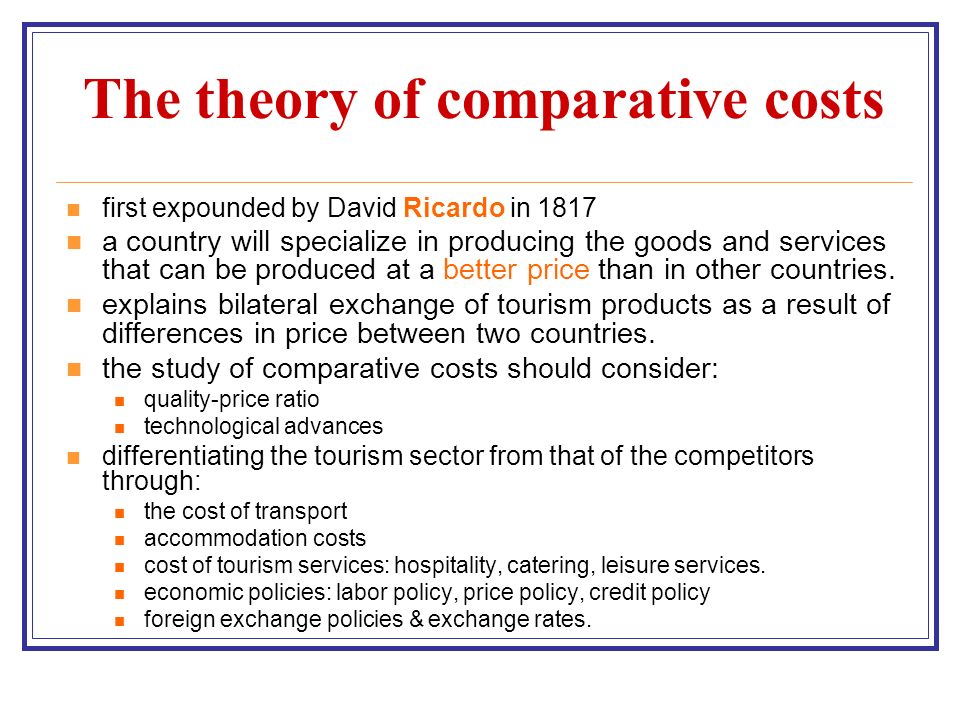Comparative advantage is what a country produces for the lowest opportunity cost. It differs from absolute and competitive advantage. Comparative advantage is what a country produces for the lowest opportunity cost. It differs from absolute and competitive advantage. After reading Adam Smiths The Wealth of Nations, he became an economist. Absolute cost advantage results from the specialization of labor proposed by Smith in his theory. Specialization of labor, or division of labor, results in a significantly higher productivity per unit of labor, and in turn, a lower cost of production. Absolute advantage theory was first presented by Adam Smith in his book The Wealth of Nations in 1776. Smith provided the first concept of a nations wealth. Adam Smith is a grandfather of economics because he introduced two important concepts that many of the new trade theories are based on these two main concepts, which are. Let us make indepth study of the theory of absolute advantage. The theory of absolute advantage was put forward by Adam Smith who argued that different countries enjoyed absolute advantage in the production of some goods which formed the basis of trade between the countries. Absolute advantage is the ability of a country, individual, company or region to produce a good or service at a lower cost per unit than another entity that produces the same good or service. The idea of comparative costs advantage is drawn in view of deficiencies observed by Ricardo in Adam Smiths principles of absolute cost advantage in explaining territorial specialisation as a basis for international trade. This video explains absolute and Comparative advantage. Adam Smith propounded the theory of absolute cost advantage as the basis of foreign trade; under such circumstances an exchange of goods will take place only if each of the two countries can produce one commodity at an absolutely lower production cost than the other country. The figure also reveals that A has an absolute advantage in the production of commodity X (OX A OX B), and country has an absolute advantage in the production of commodity Y(OY B OY A). Adam Smith based his theory of international trade on absolute differences in costs between two countries. An absolute advantage example is Michael Jordan, who is the best at playing basketball. Adam Smith introduced the absolute advantage theory in the context of a nation, but it can be applied to individuals too. Smith, who was a Scottish economist, introduced the absolute advantage theory in 1776. Adam Smiths Theory of Absolute Advantage A country is expected to export those goods in which it has an absolute cost advantage and import goods in which it has an absolute cost disadvantage (using labor theory of value) Labor hours to make: US Rest of the. Classical theory and Ricardo's formulation. Adam Smith first alluded to the concept of absolute advantage as the basis for international trade in The Wealth of Nations: If a foreign country can supply us with a commodity cheaper than we ourselves can make it, better buy it of them with some part of the produce of our own industry employed in a way in which we have some advantage. The Theory of Comparative Advantage Overview. Adam Smith wrote in The Wealth of Nations, If one country has an absolute advantage in the production of both goods (as assumed by Ricardo) then real wages of workers (i. , the purchasing power of wages) in that country will be higher in both industries compared to wages in the other. The idea of absolute advantage is different than the theory of comparative advantage, which says that nations should specialize in producing the good in which they have the lowest opportunity cost. Origin of the theory The main concept of absolute advantage is generally attributed to Adam Smith for his 1776 publication An Inquiry into the Nature and Causes of the Wealth of Nations in which he countered mercantilist ideas. Smith argued that it was impossible for all nations to become rich simultaneously by following mercantilism. Smith also stated that the wealth of. Transcript of Adam Smith's theory about absolute advantage In economics, the principle of absolute advantage refers to the ability of a party (an individual, or firm, or country) to produce more of a good or service than competitors, using the same amount of resources. absolute advantage another country in the production of a good or service if it can produce thatgood or service (the. Although Adam Smith understood and explained absolute advantage, one big thing he missed in The Wealth of Nations was the theory of comparative advantage. Most of the credit for the theory is attributed to David Ricardo, although it. Ricardo comparative advantage pdf Ricardo introduces to the economics literature a theory of comparative cost advantage which includes countries that do not have absolute advantages. ricardo theory of comparative advantage pdf ricardo comparative advantage ppt 1 Absolute and Comparative Advantage 1. 1 Adam Smiths Theory of Absolute Advantage The trade theory that rst indicated importance of specialization in production and division of labor is Comparative Advantage. In the late 1700s, the famous economist Adam Smith wrote this in the second chapter of his book The Wealth of Nations: 'It is the maxim of every prudent master of a family. Absolute advantage and comparative advantage are two terms that are widely used in international trade. Both terms deal with production, goods and services. Absolute advantage is a condition in which a country can produce particular goods at a lower cost in comparison to another country. n response to Mercantilism, Adam Smith offered his own theory of Absolute Advantage. This theory believed that a nation should specialize in producing those goods that it can produce at a cheaper cost than that of other nations. These goods should be exchanged with other goods that are being cheaply produced by the other nations. Absolute advantage refers to the superior production capabilities of a nation; comparative advantage is based on the concept of opportunity cost. Absolute advantage is the circumstance in which a company or nation is the most productive in producing a certain good or service. The efficiency is the key component of absolute advantage and does not necessarily mean that a company or nation is the most costeffective in production, just the. The theory of absolute advantage destroys the mercantilistic idea that international trade is a zerosum game. it should be allowed to flow according to market forces. quality of aftersales support) Absolute Advantage The Scottish economist Adam Smith developed the trade theory of absolute advantage in 1776. will there still be benefit to. CLASSICAL THEORIES OF INTERNATIONAL TRADE International economics, Course 2 1. Mercantilism (William Petty, Thomas Mun and Antoine de Montchrtien model) 2. The Absolute Advantage (Adam Smith model) 3. The Comparative Advantage (David Ricardo model) The essence of Adam Smith theory is that the rule that leads the exchanges from any market. The trade theory that first indicated importance of specialization in production and division of labor is based on the idea of theory of absolute advantage which is developed first by Adam Smith in his famous book The Wealth of Nations published in 1776. Absolute advantage Theory Thursday, December 22, 2016 In economics, the principle of absolute advantage refers to the ability of a party (an individual, or firm, or country) to produce a greater quantity of a good, product, or service than competitors, using the same amount of resources. Absolute Cost Advantage Theory. Free Trade occurs when a government does not attempt to influence, through tariffs, quotas, or other means. Adam Smiths theory is based on labour theory of value, which asserts that labour is the only factor of production and that in a closed economy goods exchange for one another according to the relative amounts of labour they embody. The main concept of absolute advantage is generally attributed to Adam Smith for his 1776 publication An Inquiry into the Nature and Causes of the Wealth of Nations in which he countered mercantilist ideas. This feature is not available right now. Adam Smith, the Scottish economist observed some drawbacks of existing Mercantilism Theory of International trade and he proposed a new theory i. Absolute Cost Advantage theory of International trade to remove drawbacks and to increase trade between countries. Historical Development of Historical Development of Modern Trade Theory Modern Trade Theory Absolute Cost Advantage Adam Smith Countries that use less labor to produce one unit of output Labor theory of value assumes that within a nation, labor is the only factor of production One Man output per labor Portugal Britain textile 2. David Ricardos Discovery of Comparative Advantage Roy J. Ruffin1 The SmithRicardo simple labor theory. But when a world market is established, and the prices of the two goods absolute, cost of producing commodities, the costs compared, it must be carefully noted, are the advantagein Chapter 2 The Ricardian Theory of Comparative Advantage is differences in technology. absolute advantages in production. Adam Smith wrote in The Wealth of Nations, produce it at a lower opportunity cost than another country. The opportunity cost of cloth production is One nation absolute cost advantage in one good The other nation absolute cost advantage in the other good Each nation must have a good that it is absolutely more efficient in. In this example, there is symmetry between absolute and comparative advantage. Saudi Arabia needs fewer worker hours to produce oil (absolute advantage, see Table 1 ), and also gives up the least in terms of other goods to produce oil (comparative advantage, see Table 4 ). adam smiths theory of the absolute advantage. assumptions: two countries the us Absolute Advantage and Comparative Advantage Absolute advantage and comparative advantage. Even Ricardo's sudden reference to Portugal and his absurd hypothesis that the Portuguese had an absolute advantage over Britain in the production of cloth, seem to indicate his lack of serious interest in the theory of comparative cost. According to the classical Ricardian theory of comparative advantage, relative labor productivities deter labor cost, denoted by c ijk in a common currency: (2) absolute rather than comparative advantage becomes relevant for the location of production. 5 The location of perfectly Adam Smiths principle of absolute advantage and David Ricardos principle of comparative advantage, in general, are based on the technological superiority of one country over another country in producing a commodity. A country has an absolute advantage over another in producing a good, if it can produce that good using fewer resources than another country. For example if one unit of labor in India can produce. The Theory of Absolute Advantage and Comparative Advantage 1. geographic location and transport costs Insufficient production Economic reasons Absolute advantage Comparative advantage Absolute advantage By Adam Smith in the Wealth of Nations (1776) [being able to produce at a lower real cost than another country An absolute advantage. David Ricardo and Comparative Advantage. The Theory of Comparative Advantage. David Ricardo, working in the early part of the 19th century, realised that absolute advantage was a limited case of a more general theory. Produce only goods where you are most efficient. 410 Theory of Absolute Advantage Adam Smith: Wealth of Nations (1776). trade for those where you are not efficient. The Theory of Absolute Advantage 15 20 G Cocoa 10 A K Figure 4. Adam Smith ( ) was a Scottish philosopher and economist who is best known as the author of An Inquiry into the Nature and Causes of the Wealth Of. Adam Smith first described the principle of absolute advantage in the context of international trade, using labor as the only input. Since absolute advantage is determined by a simple comparison of labor productiveness, it is possible for a party to have no absolute advantage in anything [1..











